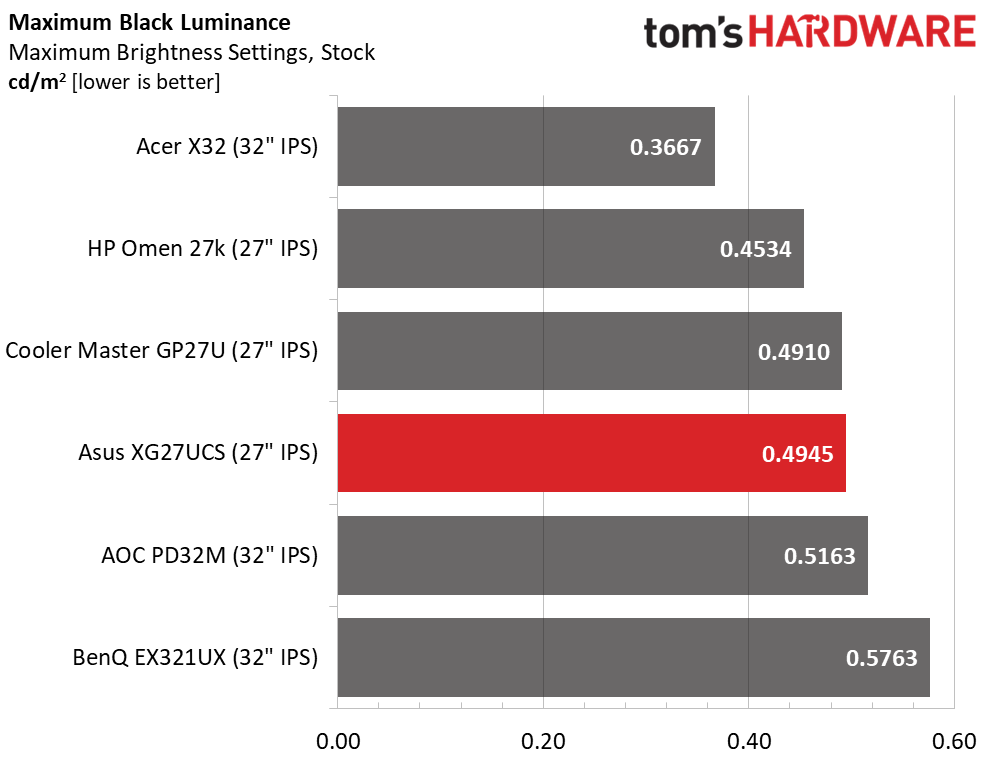Why you can trust Tom's Hardware
To read about our monitor tests in-depth, please check out Display Testing Explained: How We Test PC Monitors. We cover brightness and contrast testing on page two.
Uncalibrated – Maximum Backlight Level



Spoiler alert: this is the part of the review where I have to point out the XG27UCS’s one flaw – low contrast. As you'll see on subsequent pages, it is stellar in every other metric. But its IPS panel doesn’t have the black levels of the competition and therefore only managed 865.6:1 in my out-of-box test. This isn’t bad but it isn’t as good as most of the competition either. There is a dynamic option for SDR content that helps some, but as you’ll see later, it does not help HDR. Light output is strong at 428 nits, but again, there are Mini LED screens like the BenQ, Cooler Master, Acer and AOC that are even brighter.
After Calibration to 200 nits


Calibration to 200 nits doesn’t change anything on the contrast front, which is at least a positive indication of the XG27UCS’s consistent performance. All the screens are measured with dimming turned off, so what you see is their native contrast ratios.
That same consistency carries over to the intra-image ANSI test. The XG27UCS is well-built with quality components. It just doesn’t have a ton of dynamic range.
Test Takeaway: The XG27UCS’s low contrast is a bummer, but it is bright and colorful, nonetheless. It delivers decent performance for the money when you consider that a Mini LED or an OLED will cost more. You can get a little more punch in SDR mode with the ASCR option in the OSD. But this won’t help you with HDR content, more on that later. Now that we have that out of the way, it’s on to what the XG27UCS does well, which is everything else.
MORE: Best Gaming Monitors
MORE: How We Test PC Monitors
Get Tom's Hardware's best news and in-depth reviews, straight to your inbox.
MORE: How to Buy a PC Monitor
Current page: Brightness and Contrast
Prev Page Response, Input Lag, Viewing Angles and Uniformity Next Page Grayscale, Gamma and Color
Christian Eberle is a Contributing Editor for Tom's Hardware US. He's a veteran reviewer of A/V equipment, specializing in monitors. Christian began his obsession with tech when he built his first PC in 1991, a 286 running DOS 3.0 at a blazing 12MHz. In 2006, he undertook training from the Imaging Science Foundation in video calibration and testing and thus started a passion for precise imaging that persists to this day. He is also a professional musician with a degree from the New England Conservatory as a classical bassoonist which he used to good effect as a performer with the West Point Army Band from 1987 to 2013. He enjoys watching movies and listening to high-end audio in his custom-built home theater and can be seen riding trails near his home on a race-ready ICE VTX recumbent trike. Christian enjoys the endless summer in Florida where he lives with his wife and Chihuahua and plays with orchestras around the state.
-
truerock I just can't understand why somebody would want to put crummy, low-quality speakers inside of their monitor. It just seems like the strangest idea. They like having a monitor that vibrates?Reply
Wouldn't it be better to have good speakers? -
Sluggotg Reply
I use Nice Speakers or a Good Headset for most of my computing activities. When I am building, fixing/trouble shooting, updating, testing, etc., I use a monitor with built in speakers. Less hassle, less clutter at my computer work desk.truerock said:I just can't understand why somebody would want to put crummy, low-quality speakers inside of their monitor. It just seems like the strangest idea. They like having a monitor that vibrates?
Wouldn't it be better to have good speakers? -
Syntaximus Just picked one of these up for $370 on Amazon, totally worth it.Reply
The color accuracy out of the box is on point exactly as the review says.
I haven't even bothered trying to calibrate it yet, just adjust the brightness as needed.
No dead pixels, hardly any glow/bleed, just as perceivably snappy as my old TN.
Colors and viewing angles are great, contrast is meh, but that's IPS, and for the price I don't mind.
No issues w ghosting either so far on the #10 setting, but will probably need adjusting if tanking FPS.
